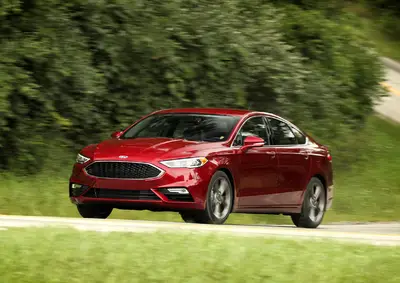2017 Ford Fusion Sport Review by Carey Russ +VIDEO
Going Where No Fusion Sedan Has Gone Before
DRIVING DOWN THE ROAD WITH CAREY RUSS
• SEE ALSO: Ford Research and Buyers Guide
When Ford used its then-new 2.7-liter “EcoBoost” twin-turbo V6 in its ever-popular F-150 pickup truck for 2015, I thought that would be a great engine for a high-performance version of the midsize Fusion sedan. Hey, Ford, remember “Total Performance”? It took a while, but that’s now the 2017 Fusion Sport. 325 horsepower, 380 lb-ft of torque, and all-wheel drive in an unassuming family sedan with sophisticated continuously-variable damping control for its fully-independent suspension. Thermonuclear Fusion in a stealth wrapper.
But not at the expense of civility and practicality. If you’re looking for a factory tuner car like the original late `80s Taurus SHO, this is not it. Ford learned a lesson there. The Fusion Sport is much more like the current Taurus SHO, a mature grand tourer, not a racer. Hence the lack of graphics and lurid aerodynamic appendages. It’s smaller and more nimble than the full-size Taurus. Technically and technologically, it’s far ahead of that near-30 year-old SHO, largely for the same reasons your mobile phone is that far ahead of a 386 PC. Not to mention advances in engineering knowledge and metallurgy. Dual overhead cam heads with four valves per cylinder were exotic technology then, mainstream now, even in economy cars. Like an increasing number of automakers, Ford is using a combination of direct fuel injection — into the combustion chamber, not the intake manifold — and turbocharging to balance power and efficiency. When power is needed, as when accelerating from a slow onramp into fast traffic, it’s there, now, no waiting. Driving at a steady speed, surprisingly little power is required. No boost, less air, less fuel, better gas mileage. Hence the “EcoBoost” moniker. Turbos have come a long way since the 1980s.
 |
The Fusion Sport is not a demanding car to drive. Turbo lag is a non-issue — what might feel like lag when stepping on the throttle at low speeds is the transmission being caught out a gear or more above the optimum for fuel economy considerations. Sport mode or manual shifting takes care of that, at the expense of fuel economy. Your choice, and even in D it’s plenty quick and responsive. As one of the premium models of the Fusion lineup, the Sport comprehensively equipped, with leather-and-Mikos “suede” sport seating and sportier interior trim standard, and most of today’s electronic convenience and safety systems either standard or available. It can troll through slow traffic without a problem, and make short work of too-short onramps when a little adrenaline is desired. The suspension combines grand touring comfort with serious ability, and thanks in no small part to that all-wheel drive and control electronics, the 380 lb-ft of torque doesn’t try to snatch the steering wheel out of your hands.
When it comes time to stop, no worries, and those brakes and excellent maneuverability mean that trouble can be easily avoided. Driver attention required there, no app for that! If the 20-mpg average I saw for my week doesn’t seem impressive, remember 325 hp and 380 lb-ft and what that used to mean. If you want to go a long way on a gallon of gasoline in a Fusion, see the Hybrid or plug-in hybrid Energi models. I saw 38 mpg from a Fusion Hybrid recently, 0-60 around 9 seconds. Sport? 20 mpg and just over 5 seconds. Choice is good, and there is a Fusion choice for everyone.
APPEARANCE: If you need to be noticed, this is not your sports sedan. With minor differences, the Sport looks just like every other 2017 Fusion. The external differences are a gloss black mesh grille in front, minor differences in the lower front bumper fascia, a “sport” badge on the rear trunk panel, and quad exhausts. And exclusive alloy wheels.
COMFORT: Inside as well, differences from other Fusion models are minimal, and no cause for complaint there. The shifter is the now-standard rotary knob on the console, with the “S” sport mode button at its center. Paddles behind the horizontal steering wheel arms handle manual shifting. The Sport gets unique matte-silver and faux carbon fiber trim on the doors and instrument panel. If not as large as the current Taurus, the Fusion is larger than the original, so interior and trunk space are good.
Front seat comfort is very good, and the rear is wide enough for three adults, at least for a little while. My test example had a number of option packages, with Group 401A is relevant here. That adds power adjustment to the front passenger seat, dual-zone automatic climate control, driver-configurable information displays to the sides of the speedometer, ambient lighting, a 12-speaker Sony audio system with all current modes, even a CD player, and the SYNC 3 infotainment system, accessed through the touchscreen in the center stack. There is a space-saver spare under the trunk floor.
SAFETY: The 2017 Fusion Sport has a full complement of airbags and a unibody structure designed and built to protect passengers. Good road manners and fine antilock four-wheel disc brakes with the AdvanceTrac stability enhancement system help drivers to avoid accidents. Available technology including radar-based blind-spot and rear cross traffic monitoring, a lane-departure warning system, and adaptive cruise control systems are available, as is Active Park Assist, which automatically drives the car into and out of parallel and some perpendicular parking spots. All of these systems were on my test car.
RIDE AND HANDLING: With a well-designed, fully-independent MacPherson strut / multilink suspension, the Fusion is a good place to start in building a contemporary sports sedan. The Continuously Controlled Damping system electronically controls shock damping in real time to provide comfort in regular driving, and better response and cornering when pushed harder. Pressing the Sport button stiffens damping and quickens steering. The system can also detect sharp surface changes, like potholes, and change damping to mitigate discomfort. It’s a pleasant car to drive, and is just as happy in traffic as playing on a back road. The driver may feel differently…
PERFORMANCE: Why would you want a “truck” engine in a sports sedan? Torque! While a high-revving engine, with torque and horsepower peaks far up its rev range, can be entertaining, such requires plenty of shifting, and is not particularly amenable to use with an automatic transmission. Ford’s 2.7-liter EcoBoost V6 in Fusion Sport tune makes its maximum torque — 380 lb-ft — at 3500 rpm, with plenty both below and above, more a torque plateau than torque curve. Which means that any of about three gears will usually be fine, the higher the better for fuel economy. That can be over-ridden. Maximum horsepower, 325, comes at a relatively low 5500 rpm, with a 6000 rpm redline. This engine is unlikely to ever be over-stressed, and won’t even be working hard in normal street use. Direct fuel injection allows a high 10:1 compression ratio even with turbocharging, for efficiency and minimal (read: nonexistent) turbo lag.
Efficiency means getting the most power out of the least amount of fuel, a win-win for performance and economy. The heavy-duty six-speed automatic shifts smoothly in normal operation. In Sport mode, lower gears are selected and held longer, with no surprise shifting in corners. Use of the paddles in D allows a temporary downshift. In Sport, you must deactivate Sport mode to get back to automatic shifting. Manually, it’s not as quick as a dual-clutch sequential manual, but it’s far smoother, and appropriate for the Fusion Sport’s personality.
CONCLUSIONS: Ford places its popular Fusion sedan into new territory with the high-performance Sport model.
SPECIFICATIONS
2017 Ford Fusion Sport
Base Price $ 33,605
Price As Tested $ 40,290
Engine Type dohc 24-valve twin-turbocharged V6 with direct fuel injection
Engine Size 2.7 liters / 164 cu. in.
Horsepower 325 @ 5500 rpm
Torque (lb-ft) 380 @ 3500 rpm
Transmission 6-speed automatic
Wheelbase / Length 112.2 in. / 191.8 in.
Curb Weight 4128 lbs.
Pounds Per Horsepower 12.7
Fuel Capacity n/a gal.
Fuel Requirement 91 octane unleaded premium gasoline for best performance, 87 octane unleaded regular permissible with decreased power
Tires P235/40R19 96W m+s Goodyear Eagle F1
Brakes, front/rear vented disc / solid disc, ABS, ESC standard
Suspension, front/rear independent MacPherson strut / independent multilink
Drivetrain transverse front engine, computer-controlled all-wheel drive
PERFORMANCE
EPA Fuel Economy - miles per gallon city / highway / observed 17 / 26 / 20
0 to 60 mph 5.2 sec
OPTIONS AND CHARGES
Equipment Group 401A — includes: Two 4.2-inch driver-configurable LCD displays in the instrument cluster, 10-way power-adjustable passenger seat, ambient lighting, dual-zone automatic climate control, Reverse Sensing System, 12-speaker Sony® audio system, SYNC® 3, 911 Assist® $ 2,000
Driver Assist Package — includes: auto high beams, BLIS blind-spot information system with cross-traffic alert, heated steering wheel, Lane- Keeping System, rain-sensing wipers, SYNC Connect, 110VAC power outlet $ 1,625
Enhanced Active Park Assist — includes: In and out assistance in parallel parking, reverse perpendicular parking, and forward and side sensing systems $ 995
Adaptive Cruise Control with Stop-and-Go includes: Pre-Collision Assist with Pedestrian Detection including Collision warning, Brake Support, Active Braking $ 1,190
Destination Charge $ 875



